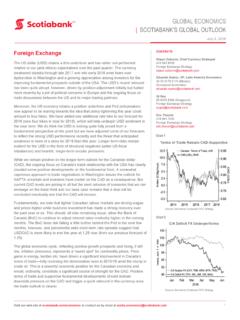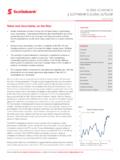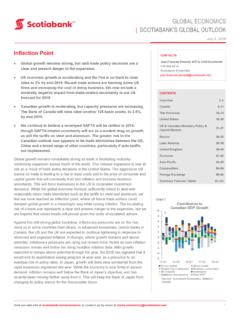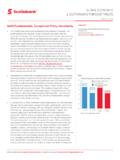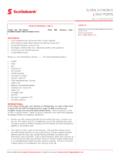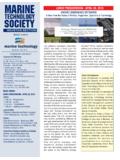Transcription of GLOBAL ECONOMICS & FOREIGN EXCHANGE …
1 1 July 3, 2018 GLOBAL ECONOMICS | SCOTIABANK S GLOBAL OUTLOOK Visit our web site at or contact us by email at FOREIGN EXCHANGE The US dollar (USD) retains a firm undertone and has rather out-performed relative to our (and others) expectations over the past quarter. The currency weakened steadily through late 2017 and into early 2018 amid fears over dysfunction in Washington and a growing appreciation among investors for the improving fundamental prospects outside of the USA. The USD s recent rebound has been quite abrupt, however, driven by position-adjustment initially but fueled more recently by a jolt of political concerns in Europe and the ongoing focus on trade discussions between the US and its major trading partners. Moreover, the US economy retains a positive undertone and Fed policymakers now appear to be leaning towards the idea that policy tightening this year could amount to four hikes.
2 We have added one additional rate hike to our forecast for 2018 (now four hikes in total for 2018), which will help underpin USD sentiment in the near term. We do think the USD is looking quite fully priced from a fundamental perspective at this point but we have adjusted some of our forecasts to reflect the strong USD performance recently and the threat that anticipated weakness is more of a story for 2019 than this year. Longer-term risks remain evident for the USD in the form of structural negatives (wider US fiscal imbalances) and bearish, longer-term secular pressures. While we remain positive on the longer term outlook for the Canadian dollar (CAD), the ongoing focus on Canada s trade relationship with the USA has clearly clouded some positive developments on the fundamental front. A somewhat capricious approach to trade negotiations in Washington leaves the outlook for NAFTA uncertain and investors have cooled on the CAD as a consequence.
3 But current CAD levels are pricing in all but the most adverse of scenarios that we can envisage on the trade front and our base case remains that a deal will be concluded eventually and that the CAD will recover. Fundamentally, we note that tighter Canadian labour markets are driving wages and prices higher while business investment has made a strong recovery over the past year or so. This should, all else remaining equal, allow the Bank of Canada (BoC) to continue to adjust interest rates modestly higher in the coming months. The BoC does risk falling a little further behind the Fed in the next few months, however, and persistently wide short-term rate spreads suggest that USDCAD is more likely to end the year at now (from our previous forecast of ). The GLOBAL economic cycle, reflecting positive growth prospects and rising, if still low, inflation pressures, represents a sweet spot for commodity prices.
4 Price gains in energy, lumber etc. have driven a significant improvement in Canada s terms of trade fully reversing the deterioration seen in 2015/16 amid the slump in crude oil. This is a powerful economic positive for the Canadian economy and would, ordinarily, constitute a significant source of strength for the CAD. Positive terms of trade and supportive fundamental developments should restrain downside pressure on the CAD and trigger a quick rebound in the currency once the trade outlook is clearer. CONTACTS Shaun Osborne, Chief Currency Strategist FOREIGN EXCHANGE Strategy Eduardo Su rez, VP, Latin America ECONOMICS (Mexico) Scotiabank ECONOMICS Qi Gao (Singapore) FOREIGN EXCHANGE Strategy Eric Theoret FOREIGN EXCHANGE Strategy xxx Sources: Macrobond, Scotiabank FICC Strategy.
5 Sources: Macrobond, Scotiabank FICC Strategy. C/A Deficit FX Underperforms Chart 2 Chart 1 Terms of Trade Remain CAD-Supportive 2 July 3, 2018 GLOBAL ECONOMICS | SCOTIABANK S GLOBAL OUTLOOK Visit our web site at or contact us by email at European currencies have borne the brunt of the USD rebound over the past quarter but we think the euro (EUR) in particular is looking somewhat oversold. Italian and Spanish political developments weighed on sentiment recently but concerns have moderated for now. We are constructive on Eurozone growth despite a soft patch in activity at the start of the year. Meanwhile, measured inflation and inflation expectations are ticking higher, supported by rising energy prices. The European Central Bank confirmed that its asset purchase program will conclude at year-end, ahead of a modest tightening in interest rates in 2019.
6 Surprisingly, this message (while not unexpected) was greeted with renewed pressure on the currency. We have reduced our near-term outlook for the EUR and now expect spot to end 2018 at ; our 2019 forecast remains unchanged ( ). The pound (GBP) is soft and looks somewhat vulnerable still in the near-term. UK rate hike expectations have receded after the Bank of England balked at raising rates in May and the UK government is struggling to develop a workable Brexit policy. We rather think near-term risks for the GBP remain negative but we also think that longer run valuation considerations should help limit GBP losses below versus the USD. We have reduced our 2018 year-end forecast for GBPUSD to and our end 2019 forecast to We expect the Mexican peso (MXN) to end this year near current levels but the MXN s recent performance has been soft, with the USD testing the MXN21 area amid a rise in broader market volatility and NAFTA-related concerns.
7 The July Presidential election is also starting to factor in investor decision-making on the MXN. Domestic and external risks suggest that the MXN will struggle to improve materially in the near-term. Despite heightened regional FX volatility (centered on Brazil and Argentina) most other major Latin American currencies had been somewhat more resilient to the recent gains in the USD. The Peruvian sol (PEN) has been supported by positive economic data that have helped keep the PEN s losses contained around versus the USD over the past quarter. More recently, heightened GLOBAL trade tensions and somewhat softer crude oil and copper prices have tended to weigh more on the Colombian and Chilean pesos, respectively. We are bearish on the Japanese yen (JPY), primarily because we expect the Bank of Japan will retain significant policy accommodation over our forecast horizon amid stubbornly low inflation.
8 The JPY may continue to attract temporary, safe-haven demand. Regional currency prospects continue to be clouded by geo-political and trade risks. However, rising interest rates and generally tighter monetary conditions do represent a clear and present threat to the more highly leveraged (current account deficit) economies, as economies have to compete more aggressively for funding and investors shift exposure to safer , surplus currencies which have tended to out-perform in recent months. We expect the Chinese yuan to remain in a broader range in the near-term but trends in the currency generally are liable to mirror developments in the major currencies performance versus the USD. The offshore Chinese yuan (CNH) will likely continue to trade at a discount to the onshore yuan (CNY) amid an escalation in US-China trade tensions.
9 We do not expect the Chinese authorities to engineer a weaker yuan to retaliate against the US at this stage. Meanwhile, the South Korean won (KRW), Taiwanese dollar (TWD) and Thai baht (THB) are more susceptible to external demand shocks than other regional currencies. Taiwan s listed companies are set to pay cash dividends worth around TWD in the June August period, which will impose upward pressure on USDTWD. India s trade deficit widened to USD in May from a month ago, intensifying ongoing concern over the nation s deteriorated external balance. We remain bearish on the Indian rupee (INR), Indonesian rupiah (IDR) and Philippine peso (PHP) as all the three economies are facing twin deficit problems. Bank Indonesia (BI) will raise its policy rate again on 28 June to defend the IDR EXCHANGE rate in our opinion.
10 The Malaysian ringgit (MYR) will continue to follow a broader market tone with a relatively lower volatility, while benefitting somewhat from resilient oil prices. Given that the Fed will stick to its gradual path of tightening and the ECB has pledged to remain accommodative, regional market sentiment will improve sharply should China successfully de-escalate trade tensions with the US and avert tit-for-tat trade measures. In the medium term, however, we remain cautious on prospects as GLOBAL liquidity tightens. July 3, 2018 GLOBAL ECONOMICS | SCOTIABANK S GLOBAL OUTLOOK Visit our web site at or contact us by email at This report has been prepared by Scotiabank ECONOMICS as a resource for the clients of Scotiabank. Opinions, estimates and projections contained herein are our own as of the date hereof and are subject to change without notice.
